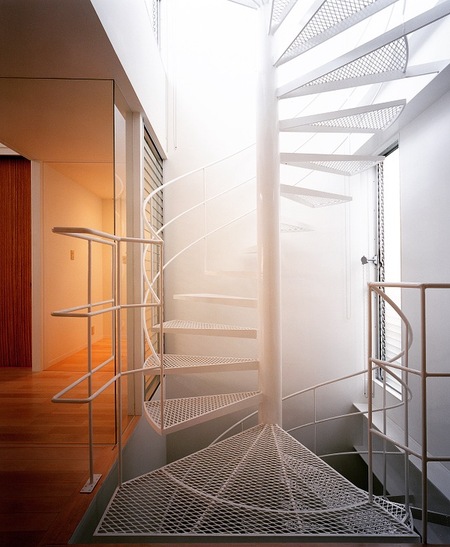階段は吹抜け
住宅設計の中で上下階の移動手段はひとつの見せ場とした。
スロープを住宅に使った事例として、すぐに思い付くのがコルビュジエのサヴォア邸で、以前、スロープは20世紀のモータリゼーションとともに主体的に扱われるようになったとしたが、このサヴォア邸はまさにモータリゼーションを体現したような住宅で、広い敷地内を自動車で運転して来て、住宅の1階の平面形状に沿って乗り入れ、そのまま住宅の中に駐車し、スロープで上階へ歩いて移動する。
スロープはもともと自動車あるいは馬車の昇降のために設けられたものだろうが、ここでは自動車を降りた人間の昇降にも使われる。
階段はスロープよりも、同じレベルの高さを上がる場合、急勾配にできるので、スロープは水平性を強調し、階段は垂直性を強調する。
たがら、住宅を設計する場合、階段は吹抜けだと考えて、光と風の通り道、特に狭小住宅では、より階段面積を小さくしたいし、光や風も取り入れたいので、螺旋階段にし、上部に光や風を取り入れる開口部を設け、段板を透かしたりもする。
"Stairs are blowouts"
The moving means of the upper and lower floors in the house design was one of the highlight.
As an example of using a slope for a house, I immediately come up with the Savoir House in Corbusier, which used to be treated mainly with motorization in the twentieth century, but this Savoir house truly embodies motorization In such a house, drive by car in a large site, ride along the flat shape of the first floor of the house, park in the house as it is, and walk to the upper floor on the slope.
Slopes may be originally provided for the lifting of cars or carriages, but they are also used here for lifting of people who got off the car.
The stairs emphasize the horizontality, and the stairs emphasize the verticality, as the stairs can be steeper if they rise the same level higher than the slope.
Therefore, when designing a house, the stairs are considered to be open-air paths, and in light and wind paths, especially in narrow houses, we want to make the stairs area smaller and to incorporate light and wind, so we make spiral stairs and light at the top Or provide an opening to take in the wind, and even see through the steps.

